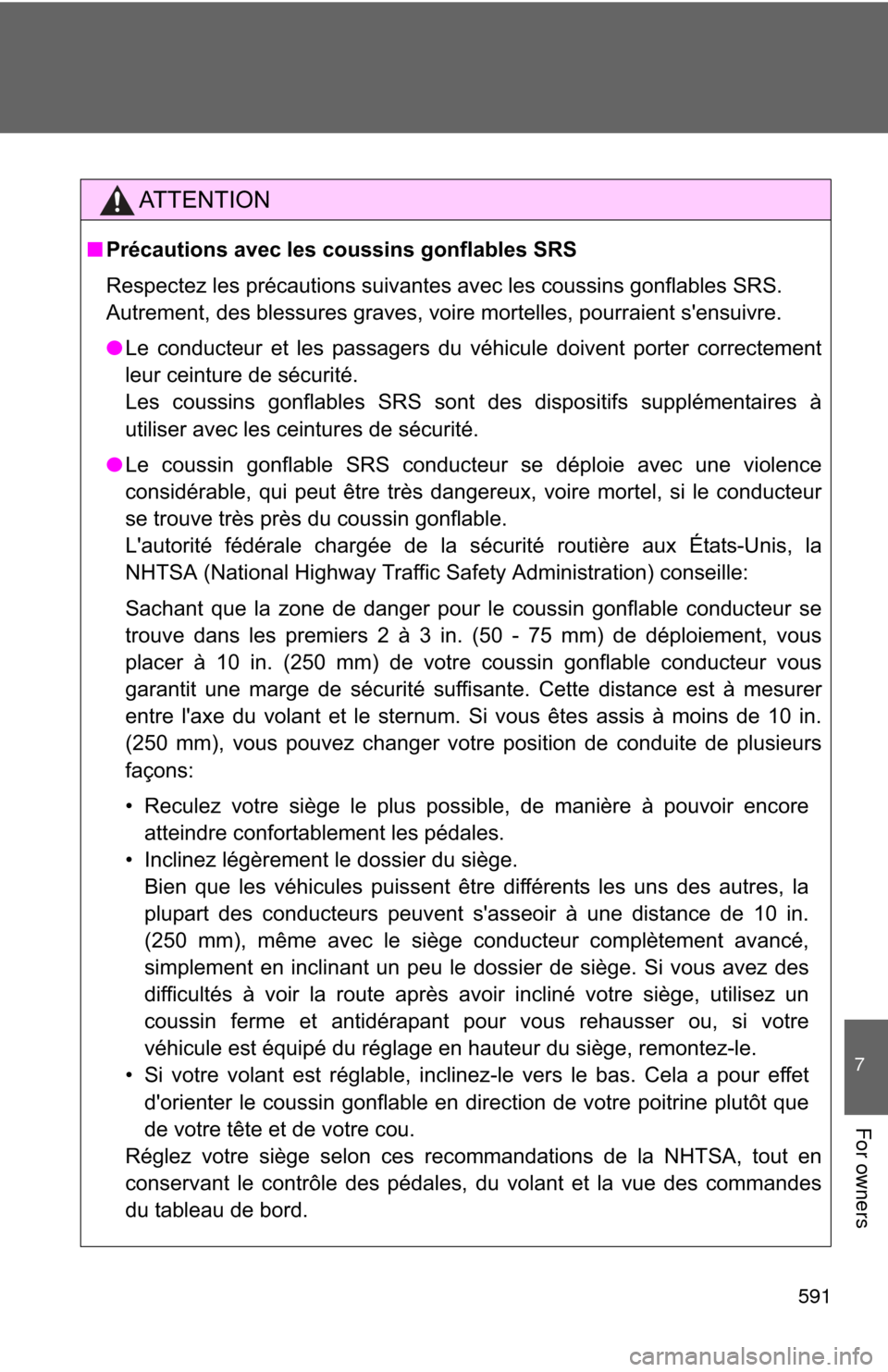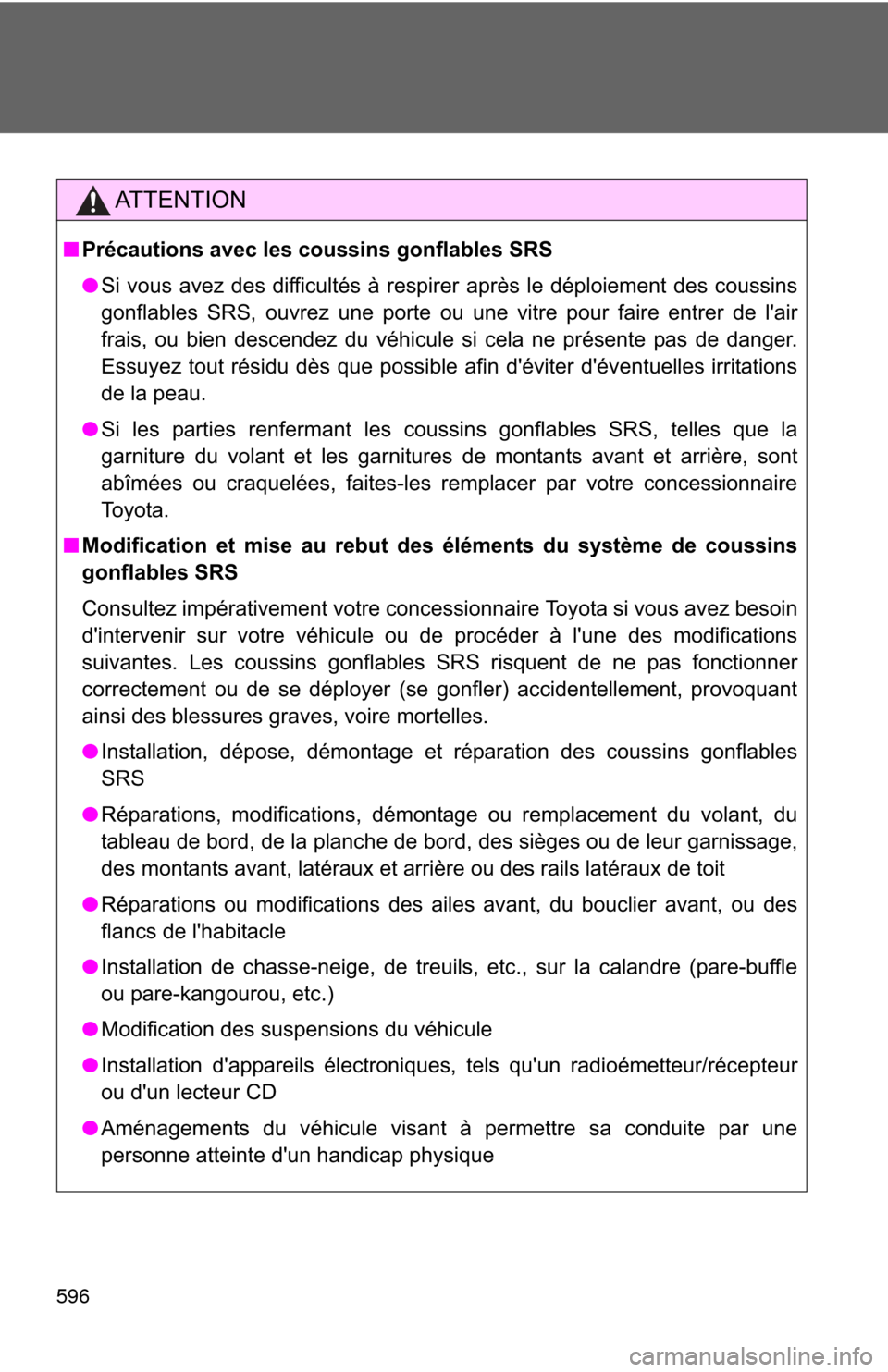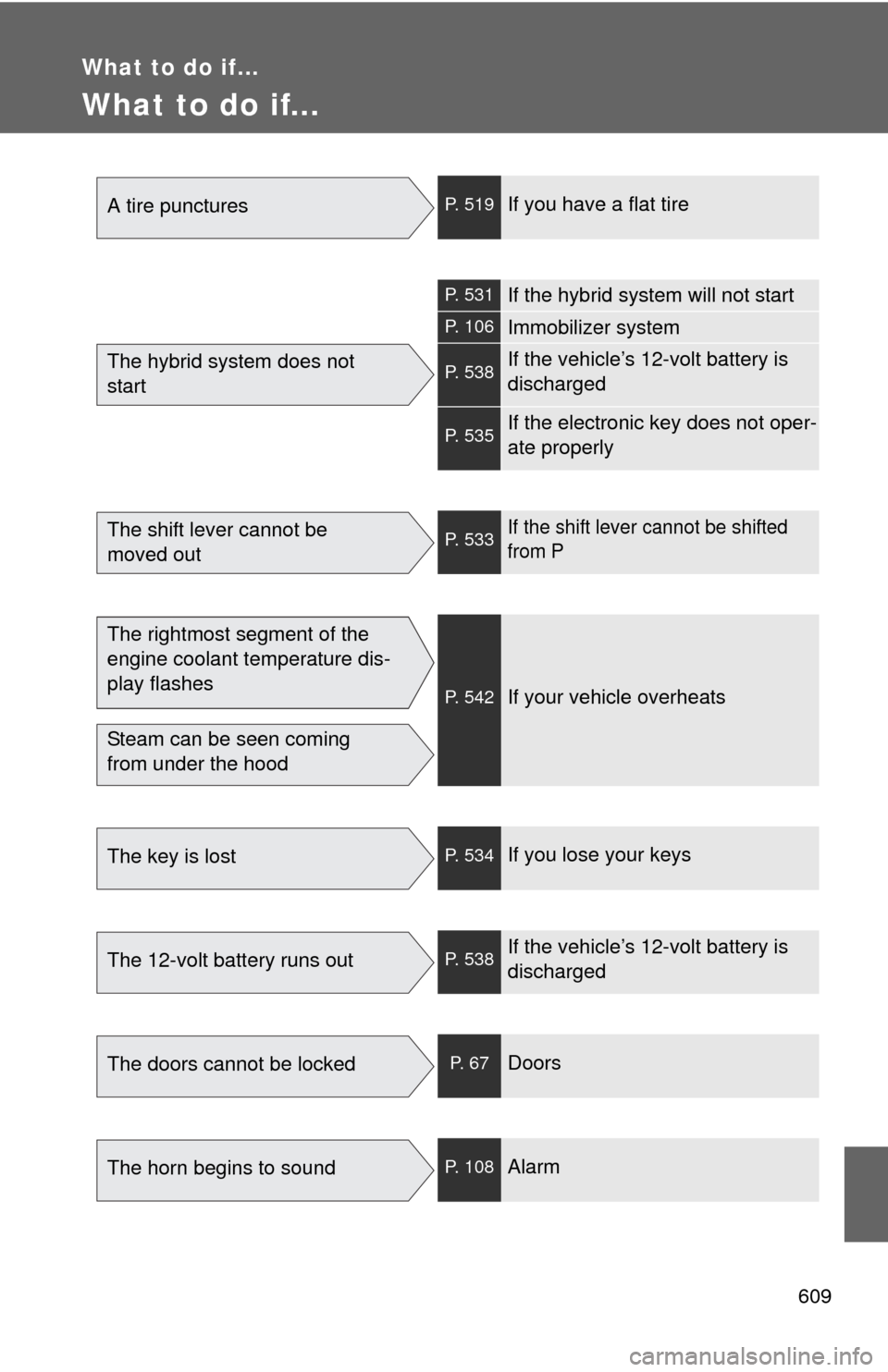2014 TOYOTA CAMRY HYBRID ESP
[x] Cancel search: ESPPage 498 of 612

498 5-2. Steps to take in an emergency
CAUTION
■If a blowout or sudden air leakage should occur (vehicles with a tire
pressure warning system)
The tire pressure warning syste m may not activate immediately.
■Maintenance of the tires (vehicles with a tire pressure warning sys-
tem)
Each tire, including the spare (if provided), should be checked monthly
when cold and inflated to the inflation pressure recommended by the
vehicle manufacturer on the vehicle placard or tire inflation pressure
label (tire and load information label). (If your vehicle has tires of a differ-
ent size than the size indicated on the vehicle placard or tire inflation
pressure label [tire and load information label], you should determine the
proper tire inflation pr essure for those tires.)
As an added safety feature, your vehicle has been equipped with a tire
pressure monitoring system (TPMS-ti re pressure warning system) that
illuminates a low tire pressure telltal e (tire pressure warning light) when
one or more of your tires is significantly under-inflated. Accordingly,
when the low tire pressu re telltale (tire pressure warning light) illumi-
nates, you should stop and check your tires as soon as possible, and
inflate them to the proper pressure. Driving on a significantly under-
inflated tire causes the tire to overheat and can lead to tire failure.
Under-inflation also reduces fuel effi ciency and tire tread life, and may
affect the vehicle's hand ling and stopping ability.
Please note that the TPMS (tire pressure warning system) is not a sub-
stitute for proper ti re maintenance, an d it is the driver's responsibility to
maintain correct tire pressure, even if under-inflation has not reached the
level to trigger illu mination of the TPMS low tire pressure telltale (tire
pressure warning light).
Page 540 of 612

540 5-2. Steps to take in an emergency
■Charging the 12-volt battery
The electricity stored in the 12-volt battery will discharge gradually even
when the vehicle is not in use, due to natural discharge and the draining
effects of certain electrical appliances. If the vehicle is left for a long time, the
12-volt battery may discharge, and the hybrid system may be unable to start.
(The 12-volt battery recharges automatically while the hybrid system is oper-
ating.)
■ Precautions when the 12-volt battery is discharged
● In some cases, it may not be possible to unlock the doors using the smart
key system when the battery is discharged. Use the wireless remote con-
trol or the mechanical key to lock or unlock the doors.
● The hybrid system may not start on the first attempt after the 12-volt bat-
tery has recharged but will start normally after the second attempt. This is
not a malfunction.
● The “POWER” switch mode is memorized by the vehicle. When the 12-
volt battery is reconnected, the system will return to the mode it was in
before the 12-volt battery was discharged. Before disconnecting the 12-
volt battery, turn the “POWER” switch off.
If you are unsure what mode the “POWER” switch was in before the 12-
volt battery discharged, be especially careful when reconnecting the 12-
volt battery.
CAUTION
■Avoiding 12-volt battery fires or explosions
Observe the following precautions to prevent accidentally igniting the flam-
mable gas that may be emitted from the 12-volt battery:
●Make sure each jumper cable is connected to the correct terminal and that
it is not unintentionally in contact with any other than the intended terminal.
● Do not allow the + and - clamps of the jumper cables to come into contact
with each other.
● Do not smoke, use matches, cigarette lighters or allow open flame near
the 12-volt battery.
Page 546 of 612

546 5-2. Steps to take in an emergency
CAUTION
■To prevent an accident or injury when inspecting under the hood of
your vehicle
● If steam is seen coming from under the hood, do not open the hood until
the steam has subsided. The engine compartment may be very hot, caus-
ing serious injuries such as burns.
● After the hybrid system has been turned off, check that on the
multi-information display and the “READY” indicator are off. When the
hybrid system is operating, the gasoline engine may automatically start, or
the cooling fans may suddenly operate even if the gasoline engine stops.
Do not touch or approach rotating parts such as the fans, which may lead
to fingers or clothing (especially a tie, a scarf or a muffler) getting caught,
resulting in serious injury.
● Do not loosen the coolant reservoir cap while the hybrid system and radia-
tor are hot.
Serious injuries, such as burns, may result from hot coolant and steam
released under pressure.
NOTICE
■When adding engine/power control unit coolant
Wait until the hybrid system has cooled down before adding engine/power
control unit coolant.
When adding coolant, do so slowly. Adding cool coolant to a hot hybrid sys-
tem too quickly can cause damage to the hybrid system.
■ To prevent damage to the cooling system
Observe the following precautions:
●Avoid contaminating the coolant with foreign matter (such as sand or dust
etc.)
● Do not use any coolant additive.
Page 569 of 612

569
6-1. Specifications
6
Vehicle specifications
■
Treadwear
The treadwear grade is a comparative rating based on the wear
rate of the tire when tested under controlled conditions on a speci-
fied government test course.
For example, a tire graded 150 would wear one and a half (1 - 1/2)
times as well on the government course as a tire graded 100.
The relative performance of tires depends upon the actual conditions
of their use. Performance may diff er significantly from the norm due
to variations in driving habits, service practices and differences in
road characteristics and climate.
■ Traction AA, A, B, C
The traction grades, from highest to lowest, are AA, A, B and C,
and they represent the tire's ability to stop on wet pavement as
measured under controlled cond itions on specified government
test surfaces of asphalt and concrete.
A tire marked C may have poor traction performance.
Warning: The traction grade assigned to this tire is based on braking
(straight ahead) traction tests and does not include cornering (turn-
ing) traction.
■ Temperature A, B, C
The temperature grades are A (the highest), B, and C, represent-
ing the tire's resistance to the generation of heat and its ability to
dissipate heat when tested under controlled conditions on a speci-
fied indoor laboratory test wheel.
Sustained high temperature can cause the material of the tire to
degenerate and reduce tire life, and excessive temperature can lead
to sudden tire failure.
Grade C corresponds to a level of performance which all passenger
car tires must meet under the Federal Motor Vehicle Safety Standard
No. 109.
Grades B and A represent higher levels of performance on the labo-
ratory test wheel than the minimum required by law.
Page 591 of 612

591
7
For owners
AT T E N T I O N
■Précautions avec les coussins gonflables SRS
Respectez les précautions suivantes avec les coussins gonflables SRS.
Autrement, des blessures graves, voire mortelles, pourraient s'ensuivre.
●Le conducteur et les passagers du véhicule doivent porter correctement
leur ceinture de sécurité.
Les coussins gonflables SRS sont des dispositifs supplémentaires à
utiliser avec les ceintures de sécurité.
● Le coussin gonflable SRS conducteur se déploie avec une violence
considérable, qui peut être très dangereux, voire mortel, si le conducteur
se trouve très près du coussin gonflable.
L'autorité fédérale chargée de la sécurité routière aux États-Unis, la
NHTSA (National Highway Traffic Safety Administration) conseille:
Sachant que la zone de danger pour le coussin gonflable conducteur se
trouve dans les premiers 2 à 3 in. (50 - 75 mm) de déploiement, vous
placer à 10 in. (250 mm) de votre coussin gonflable conducteur vous
garantit une marge de sécurité suffisante. Cette distance est à mesurer
entre l'axe du volant et le sternum. Si vous êtes assis à moins de 10 in.
(250 mm), vous pouvez changer votre position de conduite de plusieurs
façons:
• Reculez votre siège le plus possible, de manière à pouvoir encore
atteindre confortablement les pédales.
• Inclinez légèrement le dossier du siège. Bien que les véhicules puissent être différents les uns des autres, la
plupart des conducteurs peuvent s'asseoir à une distance de 10 in.
(250 mm), même avec le siège conducteur complètement avancé,
simplement en inclinant un peu le dossier de siège. Si vous avez des
difficultés à voir la route après avoir incliné votre siège, utilisez un
coussin ferme et antidérapant pour vous rehausser ou, si votre
véhicule est équipé du réglage en hauteur du siège, remontez-le.
• Si votre volant est réglable, inclinez-le vers le bas. Cela a pour effet d'orienter le coussin gonflable en direction de votre poitrine plutôt que
de votre tête et de votre cou.
Réglez votre siège selon ces recommandations de la NHTSA, tout en
conservant le contrôle des pédales, du volant et la vue des commandes
du tableau de bord.
Page 596 of 612

596
AT T E N T I O N
■Précautions avec les coussins gonflables SRS
● Si vous avez des difficultés à respirer après le déploiement des coussins
gonflables SRS, ouvrez une porte ou une vitre pour faire entrer de l'air
frais, ou bien descendez du véhicule si cela ne présente pas de danger.
Essuyez tout résidu dès que possible afin d'éviter d'éventuelles irritations
de la peau.
● Si les parties renfermant les coussins gonflables SRS, telles que la
garniture du volant et les garnitures de montants avant et arrière, sont
abîmées ou craquelées, faites-les remplacer par votre concessionnaire
To y o t a .
■ Modification et mise au rebut des éléments du système de coussins
gonflables SRS
Consultez impérativement votre concessionnaire Toyota si vous avez besoin
d'intervenir sur votre véhicule ou de procéder à l'une des modifications
suivantes. Les coussins gonflables SRS risquent de ne pas fonctionner
correctement ou de se déployer (se gonfler) accidentellement, provoquant
ainsi des blessures graves, voire mortelles.
● Installation, dépose, démontage et réparation des coussins gonflables
SRS
● Réparations, modifications, démontage ou remplacement du volant, du
tableau de bord, de la planche de bord, des sièges ou de leur garnissage,
des montants avant, latéraux et arrière ou des rails latéraux de toit
● Réparations ou modifications des ailes avant, du bouclier avant, ou des
flancs de l'habitacle
● Installation de chasse-neige, de treuils, etc., sur la calandre (pare-buffle
ou pare-kangourou, etc.)
● Modification des suspensions du véhicule
● Installation d'appareils électroniques, tels qu'un radioémetteur/récepteur
ou d'un lecteur CD
● Aménagements du véhicule visant à permettre sa conduite par une
personne atteinte d'un handicap physique
Page 609 of 612

609
What to do if...
What to do if...
A tire puncturesP. 519If you have a flat tire
The hybrid system does not
start
P. 531If the hybrid system will not start
P. 106Immobilizer system
P. 538If the vehicle’s 12-volt battery is
discharged
P. 535If the electronic key does not oper-
ate properly
The shift lever cannot be
moved outP. 533If the shift lever cannot be shifted
from P
The rightmost segment of the
engine coolant temperature dis-
play flashes
Steam can be seen coming
from under the hood
P. 542If your vehicle overheats
The key is lostP. 534If you lose your keys
The 12-volt battery runs outP. 538If the vehicle’s 12 -volt battery is
discharged
The doors cannot be lockedP. 6 7Doors
The horn begins to soundP. 108Alarm